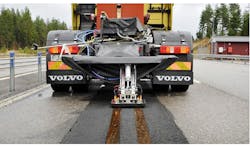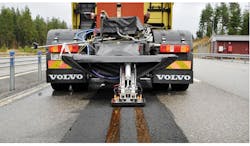Volvo has been doing research in Sweden that supplies buses and trucks with continuous electric power without carrying large batteries. Instead, power lines are built into the surface of the road, as seen in the figure. The company feels this could be a future solution for long-distance trucks and buses running on electricity.
The Volvo Group already has extensive knowledge about electric drivetrains, but in order to become world leading in sustainable transport solutions, the Volvo Group must find even more solutions that allow the vehicles to operate on renewable energy. A great deal of this energy will be distributed as electricity. However, the challenge is about supplying the vehicle with electricity power when needed.
“In city traffic, there are currently various solutions and we are researching many others. We have field tests in progress where our plug-in buses are equipped with a battery that can be charged quickly when the buses are at bus stops,” says Mats Alaküla, the Volvo Group’s expert on electric vehicles and Professor at Lund University.
But for long-distance trucks and buses, this will not work. They stop infrequently and to cope with this task they would need so many batteries that there would be no room for any loads or passengers. A solution is required where power is continuously supplied to the truck from an external source.
The Volvo Group participates in a large Swedish research project to find solutions for this, with the support of the Swedish Energy Agency. The project includes the Swedish Transport Administration, Vattenfall, several universities, vehicle manufacturers and suppliers.
The method currently being developed and tested by the Volvo Group, together with Alstom, entails two power lines built into the surface of the road along the entire length of the road. A current collector in contact with the power lines will be located on the truck.
“With this method, electric vehicles could be continuously supplied with power without carrying large batteries,” says Mats Alaküla. “The power line will be built in sections and one section is only live as the truck passes.”
Last year, Volvo built a 400-meter long track at its testing facility in Hällered outside Gothenburg. The company has been testing the system since last autumn.
“We are currently testing how to connect the electricity from the road to the truck. The electricity flows into a water-cooled heating element, with similar power requirement as an electricity-driven truck,” says Richard Sebestyen, who is the project manager at Volvo Group Trucks Technology, which is the Volvo Group’s research and development division.
However, a great deal of research still remains before this can become a reality. It involves the continued technical development of the current collector, electric motor and the control systems required. It also involves road construction, road maintenance, electricity supply along the roads and various payment models, etc.
“A lot of years remain before this is on our roads,” says Mats Alaküla.
“But, if we are to succeed in creating sustainable transport systems, we must invest significantly in research now. I am convinced that we will find a cost-efficient way to supply electricity to."
About the Author

Sam Davis Blog
Editor-In-Chief - Power Electronics
Sam Davis was the editor-in-chief of Power Electronics Technology magazine and website that is now part of Electronic Design. He has 18 years experience in electronic engineering design and management, six years in public relations and 25 years as a trade press editor. He holds a BSEE from Case-Western Reserve University, and did graduate work at the same school and UCLA. Sam was the editor for PCIM, the predecessor to Power Electronics Technology, from 1984 to 2004. His engineering experience includes circuit and system design for Litton Systems, Bunker-Ramo, Rocketdyne, and Clevite Corporation.. Design tasks included analog circuits, display systems, power supplies, underwater ordnance systems, and test systems. He also served as a program manager for a Litton Systems Navy program.
Sam is the author of Computer Data Displays, a book published by Prentice-Hall in the U.S. and Japan in 1969. He is also a recipient of the Jesse Neal Award for trade press editorial excellence, and has one patent for naval ship construction that simplifies electronic system integration.

